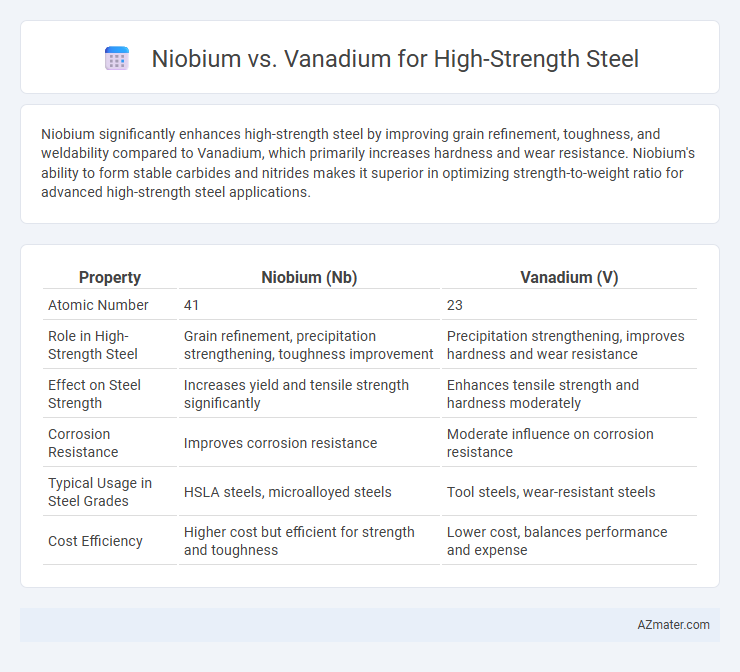Niobium significantly enhances high-strength steel by improving grain refinement, toughness, and weldability compared to Vanadium, which primarily increases hardness and wear resistance. Niobium's ability to form stable carbides and nitrides makes it superior in optimizing strength-to-weight ratio for advanced high-strength steel applications.
Table of Comparison
| Property | Niobium (Nb) | Vanadium (V) |
|---|---|---|
| Atomic Number | 41 | 23 |
| Role in High-Strength Steel | Grain refinement, precipitation strengthening, toughness improvement | Precipitation strengthening, improves hardness and wear resistance |
| Effect on Steel Strength | Increases yield and tensile strength significantly | Enhances tensile strength and hardness moderately |
| Corrosion Resistance | Improves corrosion resistance | Moderate influence on corrosion resistance |
| Typical Usage in Steel Grades | HSLA steels, microalloyed steels | Tool steels, wear-resistant steels |
| Cost Efficiency | Higher cost but efficient for strength and toughness | Lower cost, balances performance and expense |
Introduction to High-Strength Steel Alloys
High-strength steel alloys often incorporate elements like niobium and vanadium to enhance mechanical properties such as tensile strength and toughness. Niobium refines grain size and improves weldability, making it ideal for advanced high-strength steels used in automotive and structural applications. Vanadium contributes to precipitation strengthening and increased wear resistance, which is crucial for construction and heavy machinery steel grades.
Overview of Niobium and Vanadium as Alloying Elements
Niobium and vanadium are critical alloying elements used to enhance the high-strength properties of steel by refining grain structure and promoting precipitation hardening. Niobium offers superior grain refinement and improves toughness at high temperatures, making it ideal for pipeline and automotive steel applications. Vanadium contributes to strength through controlled precipitation of vanadium carbides and nitrides, significantly increasing hardness and wear resistance in tool steels and structural steels.
Chemical Properties: Niobium vs. Vanadium
Niobium exhibits a higher affinity for carbon and nitrogen, forming stable carbides and nitrides that enhance grain refinement and precipitation strengthening in high-strength steel. Vanadium also forms carbides and nitrides but with differences in solubility and coarsening behavior, influencing toughness and wear resistance. Both elements improve strength through precipitation hardening, yet niobium's chemical properties enable superior microstructural control and stability at elevated temperatures compared to vanadium.
Impact on Steel Microstructure
Niobium refines grain size and enhances precipitation strengthening by forming niobium carbides, which improve toughness and yield strength in high-strength steel microstructures. Vanadium promotes the formation of fine vanadium carbides and nitrides, contributing to increased hardness and wear resistance through precipitation hardening. Combining niobium and vanadium can synergistically optimize microstructural features, resulting in superior mechanical properties for high-strength steel applications.
Strength and Toughness: Comparative Analysis
Niobium enhances high-strength steel by significantly improving grain refinement, resulting in greater yield strength and tensile strength compared to vanadium. Vanadium contributes excellent toughness by promoting fine precipitate formation, which strengthens the steel matrix but generally offers lower overall strength than niobium alloys. The optimal balance of strength and toughness depends on precise alloy composition and heat treatment, with niobium providing superior peak strength and vanadium offering enhanced impact resistance in high-strength steel applications.
Influence on Weldability and Fabrication
Niobium enhances weldability in high-strength steel by refining grain structure and improving toughness, reducing susceptibility to cracking during fabrication. Vanadium contributes to weldability by promoting fine precipitate formation, which strengthens heat-affected zones but may increase hardness and risk of weld embrittlement. Optimizing niobium and vanadium content balances strength and ductility, ensuring improved fabrication performance and weld joint integrity in advanced steel applications.
Corrosion Resistance in High-Strength Steels
Niobium significantly enhances corrosion resistance in high-strength steels by refining grain structure and promoting a uniform passive oxide layer, reducing susceptibility to pitting and stress corrosion cracking. Vanadium, while improving strength through precipitation hardening, offers less impact on corrosion resistance compared to niobium. The superior effectiveness of niobium in maintaining durability under corrosive environments makes it preferable for applications requiring both high strength and enhanced corrosion resistance.
Cost Implications: Niobium vs. Vanadium
Niobium offers a more cost-effective solution compared to vanadium for high-strength steel applications due to its lower alloying requirements and ability to achieve similar or superior mechanical properties at reduced concentrations. Vanadium typically demands higher usage levels and can lead to increased material costs and processing expenses, impacting overall production budgets. The price stability and availability of niobium also contribute to its economic advantage in large-scale steel manufacturing.
Industrial Applications and Performance Case Studies
Niobium enhances high-strength steel's toughness and weldability, making it ideal for automotive and pipeline industries where durability and weight reduction are critical. Vanadium improves steel hardness and wear resistance, often used in tool steels and structural applications requiring superior fatigue strength. Case studies reveal niobium-alloyed steels outperform vanadium variants in large-scale infrastructure projects due to better grain refinement and corrosion resistance.
Conclusion: Choosing the Right Element for High-Strength Steel
Niobium enhances high-strength steel by significantly improving grain refinement, toughness, and weldability, making it ideal for demanding structural applications. Vanadium contributes to strength through precipitation hardening but offers less grain refinement compared to niobium. Selecting niobium or vanadium depends on specific requirements such as strength level, toughness, and processing conditions, with niobium often preferred for superior overall performance in modern high-strength steel alloys.

Infographic: Niobium vs Vanadium for High-strength Steel
 azmater.com
azmater.com